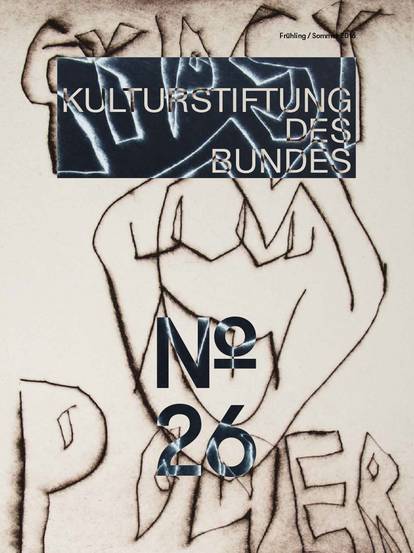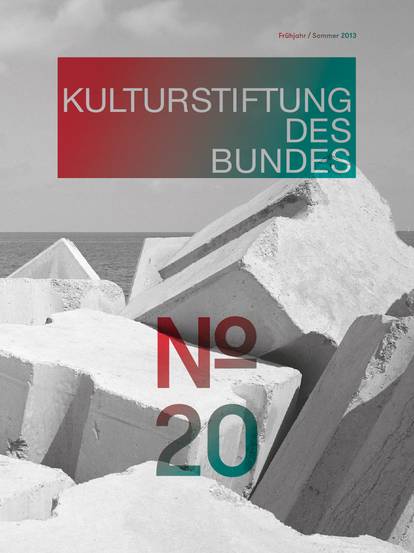Cohabitation in Cultures of Remembrance II: Historian Manuela Bauche recalls the overlaps of colonial and National Socialist racial theory.
2020 was a good year for the decolonisation movement in Germany. The project “Dekoloniale – Memory Culture in the City”, funded by the Federal Cultural Foundation and the Berlin Senate, opened in Berlin and concluded with the decision to rename M-Straße in Berlin-Mitte and Wissmannstraße in Neukölln. In that same year, the growing criticism of the Humboldt Forum began crystallising into a comprehensive societal discussion about the large-scale project. And there were vibrant debates about questionable namesakes, such as Robert Koch.
But there were some setbacks, as well. 2020 was also the year of the “Mbembe debate”. The discussion had actually little to do with the writings of Achille Mbembe, a political studies scholar now teaching in South Africa. Rather, the debate surrounded the “postcolonial theory”, of which Mbembe had been distinguished as its representative, and was accused of having an anti-Semitism problem.[1] Funding institutions which would have likely supported projects on “decolonisation” were forced to consider whether such action could result in them being accused of relativising the Shoah. Even I have lost count of the well-meant warnings I received concerning my own work, cautioning me either to take care not to relativise the Shoah or to beware of those who could accuse me of doing so. In short, commemorative politics in Germany these days are shaped by the view that attempting to remember Germany’s colonial past and attempting to revisit Germany’s Nazi past – and especially the Shoah – must necessarily run afoul of one another.[2] I don’t believe in this idea. On the contrary, I believe that both attempts can be mutually and productively stimulating.
I work at the Freie Universität in Berlin-Dahlem in a building which was originally the Kaiser Wilhelm Institute for Anthropology, Human Heredity Studies and Eugenics (KWI-A), a place where racist and ableist hereditary research was conducted. Today it houses part of the Political Studies department. My colleagues and I are working to develop a place of remembrance and information about the history of the KWI-A. This history has revealed that the stories which are usually remembered as tales of injustice are not always so easily separated from one another. Their mechanisms, functions and effects overlap in many ways. Remembering them as inherently intertwined stories is something that happens naturally.
≈
The Kaiser Wilhelm Institute for Anthropology, Human Heredity Studies and Eugenics (KWI-A) is generally remembered as a National Socialist institution. Those vaguely familiar with the name might know it had “something to do with Auschwitz” and that “Mengele had sometimes been there”. That was basically the scope of knowledge of the press when it reported in early 2015 that human and animal bone fragments had been found on the grounds of the former institute and were removed before a detailed investigation could take place. To emphasise the sensitive nature of the find, they explained “Josef Mengele had sent skeletal remains there [to the KWI-A] of people he had had murdered at Auschwitz for hereditary research purposes”.[3] And therefore, that “from the start, it was deemed possible these bone fragments could have originated from Nazi victims”.[4] All of this is true.[5] But the history of the KWI-A is considerably more complex.
The KWI-A was undoubtedly and substantially involved in National Socialist policies (and crimes); it lent them legitimacy and exploited them. The institute’s staff members saw to it that people were sterilised against their will if they were confirmed as having a “hereditary disease” or disability. The founding director Eugen Fischer and other members of the institute were responsible for “assessing” such individuals and served as “hereditary health judges” who decided on their sterilisation. They also drafted so-called “ancestry reports” which were used to identify and persecute persons of Jewish descent after 1935 if not earlier. The KWI-A also directly benefited from the Nazi policies of persecution and extermination. A case in point, dramatically recounted by the press in 2015, was a shipment of body parts taken from members of the Sinti family Mechau who were murdered at the extermination camp Auschwitz-Birkenau. These were sent to the biologist Karin Magnussen in Berlin for her research. The sender was none other Josef Mengele, who was stationed at the camp as its “doctor”. Consequently, as the underling of the second KWI-A director Otmar von Verschuer, Mengele was certainly an occasional visitor to Dahlem.
The philosophy that shaped the research work at the KWI-A was by no means developed during the National Socialist regime. The institute was founded during the era of the Weimar Republic in 1927. It operated until 1945. It was founded as a research institute with the purpose of investigating questions related to what we associate today with human genetics. What the researchers were particularly interested in, however, were those factors that determined physical and mental character traits, as well as illnesses. Were they caused by environmental factors, or was it genetics? Based on this basic research, the KWI-A sought to develop adequate eugenic measures. And this already happened in the Weimar Republic. The Sterilisation Law, passed by the Nazis in 1933, was already in the making in 1929, though no mandatory component was included in the measure. Founding director Eugen Fischer and the first head of the eugenics department Hermann Muckermann were significantly involved.
The KWI-A also played a role in the history of knowledge production that extended (at least) back to the colonial era. The founding director Fischer had built his reputation on research he had conducted in the colony of German South West Africa (today Namibia) in 1908 on some 300 descendants of white settlers and the Khoikhoi. He had claimed to have discovered proof that racial traits, with which people could be specifically identified, were passed from one generation to the next according to Mendel’s laws of inheritance, in other words, based on a specific mathematical principle. This assumption has since been roundly disproven, least of all because there are no genes with which humans can be classified into “races”. Yet the success of his study was Fischer’s ticket into the Kaiser Wilhelm Society.
Another reference to the use of colonial-period knowledge was the anthropological collection which was stored on the top floor of the institute. The specimens of the so-called “S Collection” had originally been collected by Felix von Luschan for the Berlin Ethnological Museum, most of the which during the colonial era. Via various detours, it eventually ended up at the KWI-A. Today (under the management of the Prussian Cultural Heritage Foundation (SPK)) it contains the remains of more than 5,300 persons. These were almost always obtained without the consent of the relatives. In addition to the link between the KWI-A and Auschwitz-Birkenau, this collection represents another potential explanation for the find of human remains, reported in 2015. However, this context was not mentioned by the press at the time.
Obviously, the store of knowledge and ideas that shaped the KWI-A cannot be easily cubby-holed. On one hand, we have “colonial knowledge”, on another the “eugenic knowledge of the Weimar period”, and yet on another, “Nazi knowledge”. It’s also fair to say that contemporaries wouldn’t have necessarily recognised these political or ideological turning points, but would have probably regarded the compilation of this knowledge as a continuum with occasional interruptions and shifts in focus.
“Race” and “mongrel” were two concepts that characterised this continuum. Identifying “racial differences” was the motive for establishing the anthropological collection in the colonial period. Even in the late 1920s, researchers at the institute were still examining the human remains for “racial differences”. The hope of finding “racial markers”, i.e. being able to categorise subjects by means of a simple test, was what led the second director Verschuer under the National Socialists to study blood samples taken from concentration camp prisoners to see whether it was possible to determine their racial affiliation.
The concept of the “mongrel” interested scientists at the time of Fischer’s treatise because, among other reasons, the colonial administrators asked themselves what positions and rights should be granted to those who didn’t fit into the black/white dichotomy, or the African/European or colonised/colonising, segregated society. For his part, Fischer warned that “mongrels” should under no circumstance be given the same status as Whites.
The National Socialists, however, were more interested in the idea of making Germany a white, Aryan country. The tests that Fischer’s colleague Wolfgang Abel conducted on Afro- and Asian-German children and adolescents provided the Nazi authorities with justification to forcibly sterilise about 400 of them around 1937. A dissertation written at the KWI-A on “German-Jewish mongrels” which described the absence of demarcation between Jews and non-Jews as a threat played right into the hands of the Nazi administration. In turn, the Nazis increasingly made those whom they designated as “half-Jewish” or “quarter-Jewish” the target of their policies of persecution and extermination.
≈
Those who were negatively impacted by the research projects and activities at the KWI-A were the same who are normally considered members of various “victim groups”: the disabled, Jews, Sinti, Roma, the poor, the colonised, Eastern Europeans. This list is long – and “diverse”.
Remembering the history of the KWI-A also means remembering it together with representatives of the abovementioned “groups”. In our meetings with them, we have found numerous points of consensus – consensus on the necessity of bringing together a wide variety of people; consensus that the investigations, the racialisation, degradation and persecution should be told from the perspective of the here and now – because the dynamics of dehumanisation and marginalisation obviously didn’t end in 1945 but have continued unabated in new provocations of racism, anti-Semitism, ableism and classism.
This experience is by no means unique. There is a long history of collaboration and solidarity between various groups of racialised and/or dehumanised individuals. When the Central Council of the German Sinti and Roma was founded in 1982, its mission had been supported by the Central Council of Jews in Germany. In the 1990s, women staged a whole series of feminist alliance conferences at which “female immigrants, Black German women, Jewish women and women living in exile” were able to coordinate and collaborate. Projects like verwobenegeschichten.de (interwoven histories) tell the stories of people of various walks of life and how their biographies intertwine. At the Academy of Migration & Diversity at the Jewish Museum in Berlin, various marginalised groups have been regularly invited to engage in dialogue in recent years. The humorously entitled “The Days of the Jewish-Muslim Leading Culture” implemented serious projects of solidarity in autumn 2020. Also last year, a number of communities joined Sinti and Roma protestors to demonstrate against plans to “relocate” the Memorial to the Sinti and Roma Victims of National Socialism of Europe.
The list is nowhere near complete. Even outside of Germany, there were productive and solidarity-driven projects organised between various racialised communities shortly after World War II. In 1952, the prominent Black American civil rights leader W.E.B. Du Bois was forced to rethink his statement for which he was famous: “The problem of the 20th century is the problem of the color-line”. After several visits to post-war Europe, he learned of the devastating impact of anti-Polish and anti-Jewish policies. From then on, he refrained from tying racism solely to skin colour. Du Bois expanded his concept of racism to include anti-Slavic racism and anti-Semitism. Also in France, Jewish, Black and White leftist cultural figures identified connections between the crimes committed by the Nazis and the massacres of colonists by the French government. The American literary scholar Michael Rothberg reconstructed these cases. He showed that by no means did the mutual relationships relativise the individual struggles for visibility and acknowledgement of the crimes. On the contrary, their shared ties mutually strengthened one another.
So was everything love, peace and harmony? Not quite. None of these meetings and none of these spaces are completely free of racism, anti-Semitism, ableism or classism. Nor is any place in society, for that matter. Remembrance policy is strongly characterised by currents of discontent and covetousness which arise from the fact that commemorative political space is largely structured by government decisions and the distribution of resources – decisions on what stories of injustice should be told, how much funding is awarded to the telling of them, who should receive indemnification and who shouldn’t. Discontent and covetousness, which is also directed at those to whom commemorative political privileges are ascribed. We must resist succumbing to this dynamic of “divide and conquer”. It helps to recognise this dynamic for what it is, and to remember those moments when our histories of marginalisation, dehumanisation and extermination have overlapped. And to reflect on our long history of solidarity with one another – and to further its continuation.
LITERATURE
- Tina Campt, Other Germans. Black Germans and the Politics of Race, Gender, and Memory in the Third Reich, Michigan 2005, pp. 63–80.
- Jihan Jasmin Dean, Verzwickte Verbindungen. Eine postkoloniale Perspektive auf Bündnispolitik nach 1989 und heute, in: Meron Mendel/Astrid Messerschmidt (eds.), Fragiler Konsens. Antisemitismuskritische Bildung in der Migrationsgesellschaft, Frankfurt/New York 2017, pp. 101–129.
- Michael Rothberg, Multidirectional Memory. Remembering the Holocaust in the Age of Decolonization, Stanford 2010.
- Hans-Walter Schmuhl, Grenzüberschreitungen. Das Kaiser-Wilhelm-Institut für Anthropologie, menschliche Erblehre und Eugenik 1927–1945, Göttingen 2005.
- Holger Stoecker, Human Remains als historische Quellen zur namibisch-deutschen Geschichte. Ergebnisse und Erfahrungen aus einem interdisziplinären Forschungsprojekt, in: Geert Castryck/Silke Strickrodt/Katja Werthmann (eds.), Sources and Methods for African History and Culture. Essays in Honour of Adam Jones, Leipzig 2016, pp. 469–491.
[1] Also see: Saba-Nur Cheema/Meron Mendel. Leerstelle Antisemitismus, in: tageszeitung 25 April 2020, online: https://taz.de/Postkoloniale-Theoretiker/!5678482/ (external link, opens in a new window) (accessed on 14 January 2021).
[2] A problematic aspect here is that this ignores the National Socialist genocide of the Sinti and Roma.
[3] Götz Aly, Bitte keine Ausflüchte! In: tagesspiegel.de, 19 February 2015, online: https://www.tagesspiegel.de/wissen/umgangmit- ueberresten-von-moeglichen-ns-opfernbitte-keine-ausfluechte/11396552.html (external link, opens in a new window) (accessed on 13 January 2021).
[4] Anja Kühne, Neue Widersprüche bei Skelettreisen auf dem FU-Campus, in: tagesspiegel.de, 6 February 2015, online: https://www.tagesspiegel.de/wissen/heikler-fund-neue-widersprueche-beiskelettresten-auf-dem-fu-campus/11333914.html (external link, opens in a new window) (accessed on 13 January 2021).
[5] Though to be exact – but just as horrifying – these were not skeletal remains, but rather various organs of the murdered victims which Mengele had sent to Dahlem.

![[Translate to English:] Magazine 38](/fileadmin/_processed_/f/1/csm_Magazin38_Cover-Vorschau_921x1230_689f428dc3.jpg)
![[Translate to English:] Magazine 37](/fileadmin/_processed_/b/c/csm_Mag37_Cover-Vorschau_921x1230_b5129fdb2a.jpg)
![[Translate to English:] Magazine 36](/fileadmin/_processed_/2/a/csm_Cover_Magazin36__issuu_2f3cef97bb.jpg)





![[Translate to English:] Magazine 30](/fileadmin/_processed_/c/b/csm_magazin30_vorschau_9005f773d3.jpg)














